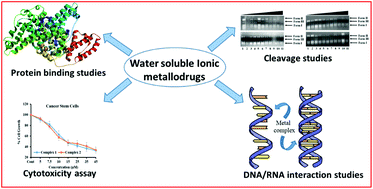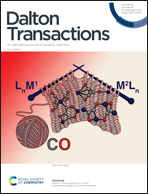Water soluble ionic Co(ii), Cu(ii) and Zn(ii) diimine–glycinate complexes targeted to tRNA: structural description, in vitro comparative binding, cleavage and cytotoxic studies towards chemoresistant prostate cancer cells†
Abstract
Four new water soluble Co(II), Cu(II) and Zn(II) ionic metal complexes (1–4) [Cu(diimine)(H2O)2(glycinate)]+[glycinate]−, [Co(diimine)(H2O)4]+[glycinate]− and [Zn(diimine) (H2O)4]+[glycinate]−, where diimine = 2,2′-bipyridine (1–3) and 1,10-phenanthroline (4) were synthesized and thoroughly characterized by spectroscopic and single X-ray crystallographic studies. Complex 1 possesses a triclinic crystal system with a penta-coordinated geometry whereas complexes 2–4 crystallized in an isostructural monoclinic system having distorted octahedral geometry. Density functional theory (DFT) studies for complexes 1–4 were performed to correlate their geometrical parameters and to calculate the energy of frontier molecular orbitals. The corroborative results of spectroscopic and voltammetric studies with ct-DNA and tRNA revealed that the complexes bind noncovalently via an electrostatic mode of binding with specificity for tRNA as compared to ct-DNA. Gel electrophoresis experiments revealed that all the complexes unwind the plasmid pBR322 DNA at low micromolar concentrations (2–9 μM) following an oxidative mechanism for Cu(II) and Co(II) complexes (1, 2 and 4) whereas the Zn(II) complex (3) mediates DNA cleavage by the hydrolytic pathway. The tRNA cleavage showed concentration and time dependent activity of the complexes to promote RNA hydrolysis. Furthermore, the BSA binding ability of complexes 1–4 was monitored, which revealed that the complexes could quench the intrinsic fluorescence in a static manner. Complexes 1–4 were found to be non-toxic towards normal prostate epithelial cells, PNT2, but were potent against chemoresistant metastatic prostate cancer cells, Du145, with GI50 values ranging from 12.75–37 μM. Complexes 1 and 2 also showed cytotoxic activity against cancer stem cells having GI50 values of 14.70 and 14.90 μM, respectively. Molecular docking studies were performed with DNA and tRNA which further validated the spectroscopic analysis demonstrating the higher binding affinity of the complexes towards tRNA.



 Please wait while we load your content...
Please wait while we load your content...